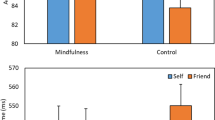Abstract
The multiplicity of terms employed in the literature of behavior analysis to tact stimuli associated with inhibition effects is considered. It is submitted that whereas there is diversity in the conditioning histories associated with inhibitory stimulus control, there is commonality in the controlling properties invested in contiguous stimuli by those various histories. The author contends that there is heuristic value in organizing the scientific language of behavior analysts on this topic around inhibition as a process. It is further suggested that the many tacts for inhibition-related stimuli, divided as they are along what might be called procedural lines, distract from what is argued here to be the core operation, viz., stimulus mediated inhibition.
Similar content being viewed by others
References
Azrin, N. H. & Holz, W. C. (1966). Punishment. In Honig, W. K. (Ed.), Operant behavior: Areas of research and application (pp. 380–447). New York: Appleton-Century-Crofts.
Baer, D. M., Wolf, M. M. & Risley, T. R. (1968). Some dimensions of applied behavior analysis. Journal of Applied Behavior Analysis, 1, 91–97.
Billingsley, F. F. & Romer, L. T. (1983). Response prompting and the transfer of stimulus control: Methods, research and a conceptual framework. Journal of the Association for the Severely Handicapped, 8, 3–12.
Catania, A. C. (1979). Learning. Englewood Cliffs, NJ: Prentice-Hall.
Falvey, M., Brown, L., Lyon, S., Baumgart, D. & Schroeder, J. (1980). Strategies for using cues and correction procedures. In W. Sailor, B. Wilcox & L. Brown (Eds.), Methods of instruction for severely handicapped students. Baltimore: Paul H. Brookes.
Ferster, C. B. & Appel, J. B. (1961). Punishment of S-delta responding in matching to sample by timeout from positive reinforcement. Journal of the Experimental Analysis of Behavior, 4, 45–56.
Hearst, E. (1969). Excitation, inhibition, and discrimination learning. In N. J. Mackintosh & W. K. Honig (Eds.), Fundamental issues in associative learning. Halifax: Dalhousie University Press.
Hearst, E., Besley, S. & Farthing, G. W (1970). Inhibition and the stimulus control of operant behavior. Journal of the Experimental Analysis of Behavior, 14, 373–409.
Hineline, P. N. (1980). The language of behavior analysis: Its community, its functions and its limitations. Behaviorism, 8, 67–86.
Honig, W. K., Boneau, C. A., Burstein, K. R. & Penny-packer, H. S. (1963). Positive and negative generalization gradients obtained after equivalent training conditions. Journal of Comparative and Physiological Psychology, 56, 111–116.
Mackintosh, N. J. (1977). Stimulus control: Attentional factors. In W. K. Honig & J. E. R. Staddon (Eds.) Handbook of operant behavior (pp. 481–513). Englewood Cliffs, NJ: Prentice Hall.
Miller, L. K. (1980). Principles of everyday behavior analysis (2nd ed.). Monterrey: Brooks/Cole.
Rilling, M. (1977). Stimulus control and inhibitory process. In W. K. Honig & J. E. R. Staddon (Eds.), Handbook of operant behavior (pp. 432–480). Englewood Cliffs, NJ: Prentice-Hall.
Skinner, B. F. (1974). About behaviorism. New York: Vintage.
Sulzer, B. & Mayer, G. (1972). Behavior modification procedures for school personnel. Hinsdale, IL: Dryden Press.
Woods, T. S. (1980). Bringing autistic self-stimulatory behavior under S-delta stimulus control. B. C. Journal of Special Education, 4, 61–70.
Woods, T. S. (1983a). The selective suppression of a stereotypy in an autistic child: A stimulus control approach. Behavioral Psychotherapy, 11, 235–248.
Woods, T. S. (1983b). DRO and DRI: A false dichotomy? The Psychological Record, 33, 59–66.
Woods, T. S. (1984). Generality in the tacting of autistic children as a function of “naturalness’ in antecedent control. Journal of Behavior Therapy and Experimental Psychiatry, 15, 27–32.
Woods, T. S. (1987). The technology of teaching: A behavior analytic approach. In A. Donnellan, D. P. Cohen & R. Paul (Eds.), A handbook of autism and disorders of atypical development. New York; John Wiley and Sons.
Author information
Authors and Affiliations
Rights and permissions
About this article
Cite this article
Woods, T.S. On diversity in the terminology concerning inhibitory stimulus control: Implications for practitioners of applied behavior analysis. Analysis Verbal Behav 5, 77–79 (1987). https://doi.org/10.1007/BF03392822
Published:
Issue Date:
DOI: https://doi.org/10.1007/BF03392822




